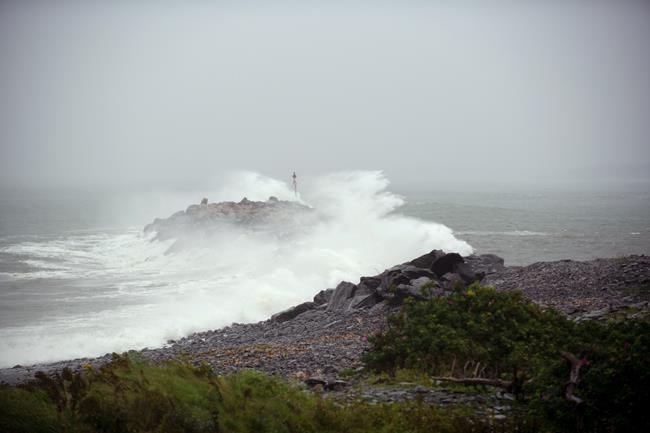HALIFAX — Thousands remained without power Sunday as post-tropical storm Lee gradually moved out of the Maritimes, leaving a trail of downed trees and coastlines damaged by pounding surf.
By midday the storm had moved past Prince Edward Island and into the Gulf of St. Lawrence where it was to pass west of the Magdalen Islands and reach northern Newfoundland in the evening hours.
“Being such a large storm, some areas are going to feel the winds from this for a few hours to come … but certainly not as strong as it was when it approached the Maritimes so it will continue to weaken,” said Bob Robichaud of the Canadian Hurricane Centre earlier Sunday.
The town of Shelburne in southwestern Nova Scotia saw the full fury of the storm when it hit Saturday and sustained some flooding from a powerful storm surge in its harbour.
“There is no question we had pretty close to a direct hit,” said Andy Blackmer, commodore of the Shelburne Harbour Yacht Club. “Significant winds with a very high tide and storm surge on top of that flooded low lying areas and some town infrastructure was damaged.”
Blackmer said a sailboat on a private mooring broke free at one point and was later secured across the harbour by two members of the yacht club.
“Driving around town there are some branches down, but overall things look pretty reasonable except we’ve been out of power for over 24 hours,” he said.
Blackmer said the conditions improved during high tide in the evening, sparing the town any further damage from ocean waters.
“We were lucky that the timing of the winds and the tide were in our favour. It could have been a lot worse.”
Further along the province’s South Shore to the northeast, Marlene and Gary Ramey were on the front lawn of their home in Bridgewater with rakes in hand. They were cleaning up a thick layer of shredded leaves and branches under a cloudy sky Sunday.
Gary Ramey described the winds that hit the town the day before as “howling.”
“We have some big oaks around us and to watch them move in the wind was kind of intimidating, but overall we ended up with no trees down and none of the neighbours have any trees down and it’s just cleaning up lots of limbs and lots of leaves,” he said.
By 1 p.m. local time, almost 13,000 Bridgewater homes and businesses were still without power. Only Halifax was reporting more outages at 16,000.
In Bridgewater and other nearby towns, fast-food outlets were doing a roaring business as residents without electricity stopped for a coffee, a hot meal and wifi access. Marlene Ramey said she was among those after their morning cup.
“I went for Tim’s and they were lined right out to the highway, but I wanted my coffee so I stayed,” she said with a laugh.
Nova Scotia Power said it had about 800 people working in communities across the province to restore electricity. At the height of the storm on Saturday, it said about 277,000 customers were affected by powerful winds that caused trees to come down on power lines.
The private utility said western Nova Scotia and the Halifax area were hardest hit, along with Truro and New Glasgow in the northeast of the province.
On New Brunswick’s Grand Manan Island, which saw upwards of 100 millimetres of rain, village Mayor Bonnie Morse said there had been no reports of major flooding.
“There were a few pools on the road, but nothing significant that warranted a road closure,” said Morse.
And although there were power outages at the height of the storm, Morse said NB-Power crews had quickly restored electricity to most homes and businesses in the area.
“Everybody is doing some cleanup today from trees and limbs that are down, but for the most part we survived it pretty good,” the mayor said.
In St. George, N.B., the only indication that Lee went through the area was at Canal Beach where a metal wharf had been dragged a few metres and lay partially submerged in the water.
Deborah Breau, who works at the toll booth at the nearby Blacks Harbour ferry terminal, said the storm was “not overly” as bad as she expected.
“But it did knock my fence down and there were some trees down,” Breau said.
In Halifax, officials were taking stock of the damage caused by high wind gusts Saturday and a storm surge that hurled large rocks and boulders onto some coastal roads.
As the cleanup continued, the city was dealing with as many as 130 toppled trees as well as some road washouts.
“The roads still need some work but they are passable with caution,” said Erica Fleck, the municipality’s chief of emergency management. She said excavators had been brought in overnight to help clear debris from the road to Peggy’s Cove in particular, which had been jammed with large rocks and other debris.
“Our biggest issue right now is no power and intermittent cell and internet service from Bell outages,” Fleck said.
Meanwhile, Robichaud said Lee held no surprises for forecasters.
“What we were predicting was a strong tropical or post-tropical storm and that’s exactly what we got,” he said. “We got winds of over 100 kilometres per hour, but just below hurricane strength.”
In Quebec Sunday, Environment Canada issued rainfall warnings across the province’s Lower North Shore, which sits above the Gulf of St. Lawrence.
The cyclone was expected to unleash between 30 and 50 millimetres of rain there with the possibility of flash floods and washouts. The downpour was forecasted to let up in the evening.
This report by The Canadian Press was first published Sept. 17, 2023.
- With files from Keith Doucette in Halifax and Christopher Reynolds in Montreal
Michael MacDonald and Hina Alam, The Canadian Press


